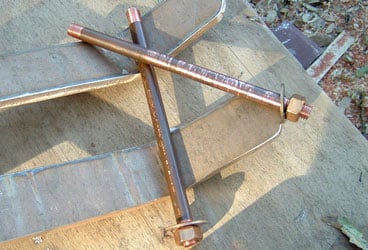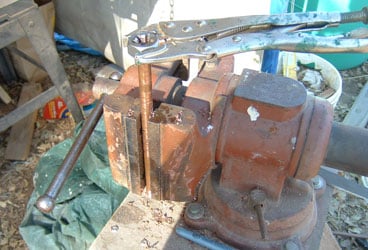
Make your own bronze bolts
It happens, sooner or later, to every do-it-yourself boat owner: Some vital deck fitting or rig component needs a size of bolt or pin that simply can’t be found, costs a small fortune, or is only sold by the gross when a mere two will do. Having fabricated most of the fittings for my Cape George 31-foot cutter, Ganymede, out of bronze plate stock, I needed lots of specialty length and diameter bolts. There’s a pretty good selection of smaller bronze screws, nuts, and washers available from West Marine, Jamestown Distributors, and Hamilton Marine, but for bolts larger than 1/4-inch, the selection gets pretty slim, not to mention expensive. Certain specialty bolt retailers, such as McMaster-Carr and Midwest Fasteners, fill this void a little, but it seems that there isn’t enough demand for 7-inch bronze bolts with 1/2-inch diameters to make it worth the while to carry them in stock—if anyone even makes them. The obvious solution is threaded rod, sometimes known as all thread, which the retailers listed above sell in various lengths and diameters. You saw off a piece of the proper length, put a nut and washer on each end, and your custom-length bolt is ready to go.
But what about those times when you only want threads at the end, or not at all, as with clevis pins? Here’s where solid rod comes into its own. This is available in more varied sizes and lengths than threaded rod (OnlineMetals.com has a great selection) and is often cheaper since there’s no threads milled in. To make clevis pins, simply saw off the length you need and use a drill press to bore a hole for a cotter pin in either end. If you’re making a lot, a simple jig in the drill-press vise will ensure they’re all the same. It helps, when drilling in rod, to start the hole with a center punch, since a cotter pin-sized drill bit is usually small (about 1/8-inch) and can bend and skitter along the rod pretty easily.

| |When milling the threads, be sure to use plenty of cutting oil, which cools and lubricates the metal, and a sharp cutting die.|
When a nut is needed at each end of your rod, thread-cutting dies are a wonderful investment. Most of Ganymede‘s longer bolts are made from 7/16-inch and 1/2-inch bronze rod stock whose ends I threaded myself with the help of a bench vise and cutting oil. I never tried threading stainless steel, which is far harder, and any rod more than half an inch thick was too tough for me to start the die on. (I had to take the 3/4-inch rudder pintle pins to a machinist to thread.) Even 1/2-inch bronze rod, if the die is starting to dull, can be difficult, and it helps to file or grind down the very end of the rod into a sort of cone so that the die can start cutting more easily. Sometimes, especially when everything’s getting oily, the vise can’t hold the rod from spinning. A little flat area filed into the rod where it goes through the vise jaws helps prevent that.
I keep all the leftover odds and ends of plate and rod stock in my tool locker, along with a handful of each size of nuts and washers, and as we cruise and things have needed fixing or modifying, there hasn’t been a fastening challenge that I haven’t been able to rise to using only the things I keep aboard.
Ben Zartman, his wife, Danielle, and their three daughters are currently feeding the cruising kitty in Newport, Rhode Island, and planning their next voyage aboard Ganymede.








